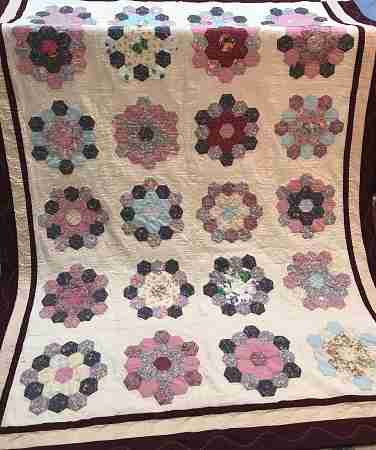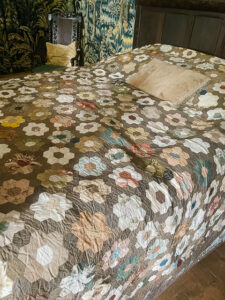A Hexie Mystery

Hexagon shapes (or “hexies” as quilters usually call them) are great little blocks for quilting. They come in many sizes. Not only that, there are many ways to make them and use them in quilting. Hexagon quilts are a very popular, traditional method. Sometimes, we even run across a real hexie mystery.
Traditionally, when a quilter thinks of hexagons, EPP (English paper piecing) comes to mind. This is a great method for the quilter who loves to sew by hand. It produces beautiful and much admired results. However, for myself, I find this method very arduous and time-consuming. Below is a photo of a vintage EPP hexagon quilt on display at the Chavenage Estate in Gloucestershire, England. Notably, this quilt most probably dates back to the early 1800’s. Can you imagine how long the quilter/quilters must have worked to complete this beautiful quilt?

In addition to this traditional method, there are several faster ways to make hexies. For example, I like to use an applique method. First, I cut out a hexagon shape using a template. Next, I either use it as is or I add borders to it and then applique the finished piece to a background quilt block to make a sort of ‘floating’ hexie quilt top. Or, I might place all the finished hexagons together in a pattern (they link together so nicely) on a background fabric such as a plain calico. So that these all hold together while stitching down, I use a light fusible web product.
At times, half hexagons are required. For example, when piecing along the edge of a quilt top to make a straight edge. In this case, a half-hexie template is very helpful.
A quick method for printing your hexagons directly onto fabric is Inklingo. Uniquely, this method does not involve measuring or templates, yet still delivers precise, accurate shapes.
Read about a hexie mystery in an interesting article by Debi Warner for “Quilting Hub”. (Apologies, “Quilting Hub” closed down on 1 October 2025.)
Read more posts from Red Bridge Quilts.
What do you think?
*Cookies are disabled on comments made on posts. Your email address will not be displayed. By submitting this form, you consent to having this website temporarily store your submitted information solely for the purpose of responding to your message.






